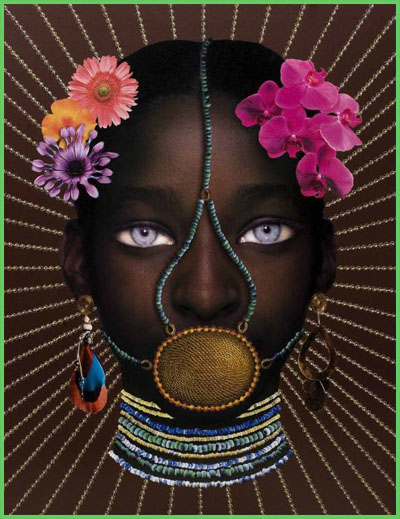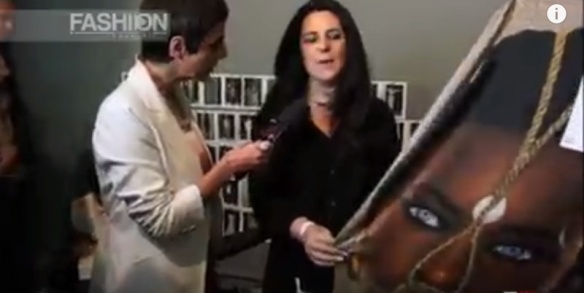Racism rears its ugly head in fashion. Yep. I just went on and put it out there. One fashion designer, whose creativity had obviously tapped out, resorted to racial degradation in order to ensure her line made the runway. Seemingly inspired by the Brazilian folklore surrounding a chattel slave named Escrava Anastácia (Slave Anastasia), designer Adriana Degreas chose to fashion a garment featuring the muzzle the beautiful slave was forced to wear.
As Model No. 2, Shirley Mallman, sashayed Degreas’ creation down the 2012 Sao Paulo Fashion Week runway. My first reaction when I saw the creation was how the model felt about having to wear it. Her expressionless gaze

Two Adriana Degreas fashions featuring Brazilian slave Anastácia and styling a swimwear accessory based on a slave muzzle.
did a good job of hiding any disgust there may (or may not) have been. But the model was not my main concern. A couple of search strings brought me right to the event and the designer.
This show ran Degreas’ 2012/2013 swimwear line. You won’t have to watch the entire video. In fact, Degreas was so inclined toward featuring her creation that she opened the collection with both of her slavery-inspired designs. I’m not sure of the size of the troupe; but there was one Black model out of the first seven that walked.
- Garment No. 1 was the swimsuit with the muzzle as an accessory.
- Garment No. 2 was the dress depicting a muzzled Black woman.
- Model No. 3 was Black. Degreas made sure her skintone matched that of the face on the previous garment.
- Garment No. 4 also featured the muzzle as an accessory.
So she opened the show with these pieces; and the video fades from the seventh model to the finale including the entire troupe. It appears the pieces were the anchor for this collection.
“The case of Anastácia suggests how a particularly evocative and powerful image can function as the material ground upon which the processes of cultural imagination and folk memory coalesce, and how a popular image can serve as a repository of values and ideas quite different from those of its creation.” (Escrava Anastácia: The Iconographic History of a Brazilian Popular Saint)
For the sake of relevancy, I developed a detailed overview of how Anastácia is regarded in Brazilian culture today. The 2011 show sparked a protest about the lack of Black Models at Sao Paulo Fashion Week. Now, I’m wondering if this design was a rebuttal to the protest — a statement piece. Did Degreas take it upon herself? Or did SPFW give her license?
As with most folklore, the story of Anastácia depends on who you talk to. Black Then tells of a beautiful slave woman with piercing blue eyes whose owner sent her away to hide from his wife the indiscretion that he fathered her with an enslaved woman. Of all the versions in Jerome Handler’s The Iconographic History of a Brazilian Popular Saint, the most fascinating was the tale that Anastácia was raped by an overseer and

1839 print by Artist Jacques Etienne Arago “Castigo de Escravos” (“Punishment for Slaves”)
other whites and subsequently birthed several blue-eyed children as a result. The story goes that Anastácia never allowed him to kiss her. So she was made to wear the mask because she refused “her lips to the overseer’s kiss.” The facebook post that brought Anastácia to my attention says the slave owner made her wear the mask as punishment for spurning his advances. Finally, one of the first versions I read said Anastácia was made to wear the muzzle/mask because she was too vocal about the treatment of slaves.
Pages 26 and 27 of Handlers, however, talk about how the popular image, actually entitled Punishment for Slaves came to be erroneously attributed to Anastácia. An unobjective look at the print impressed upon me that the subject appeared to be masculine. And Arago, himself, referred to his subject as male. Interesting reading.
I’m glad to have learned about Anastácia. However, I think plastering her likeness, or the idea that memorializes her, on a garment to be strutted around on a catwalk shows the level of disrespect that Brazil still holds for Afro-Brazilians. It also solidifies the case for global White Supremacy (Racism).

Santa Escrava Anastácia (Saint Slave Anastasia) Santa Escrava Anastácia is especially popular in Umbanda religion traditions. Her story vacillates between either a kidnapped princess from Nigeria or a slave born in Brazil. Legend dictates that Anastácia was a healer and was also known for her unusual beauty which was punctuated by her blue eyes. She was forced to wear a muzzle and collar. She eventually contracted tetanus from the collar; and it killed her. Legend is that she forgave her captors and even healed their children as she lay dying.
For Further Reading:
- November 13, 2013: Afro-Brazilian Models Slam Racism in Brazil’s Fashion Shows
- March 20, 2012: The Story of The Legendary Icon Anastácia: Escrava Anastacia
- May 22, 2009: 10% of models in Brazilian fashion week ‘must be black’

Designer Adriana Degreas being interviewed at 2012 Sao Paulo Fashion Week. I’d love to have been a fly on the wall to hear this exchange.
